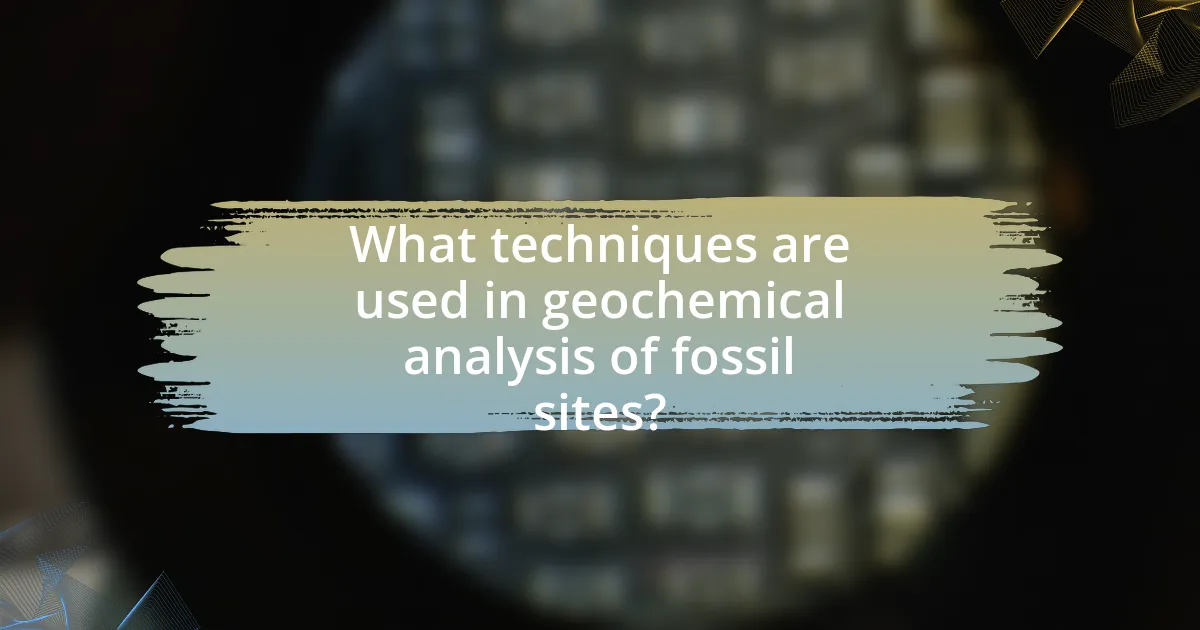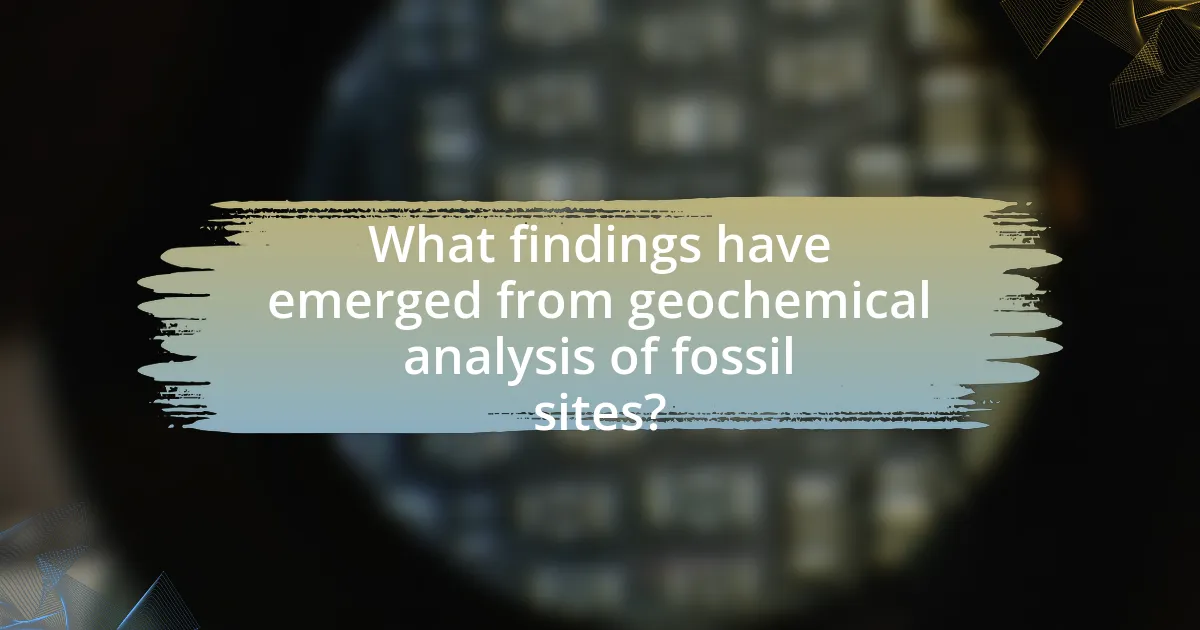Geochemical analysis of fossil sites involves studying the chemical composition and properties of fossils and their surrounding sediments to gain insights into past environmental conditions and biological processes. This article outlines the techniques used in geochemical analysis, such as mass spectrometry and X-ray fluorescence, and discusses their applications in reconstructing ancient climates, determining dietary habits of extinct species, and understanding diagenetic histories. Key findings from geochemical studies reveal significant patterns in isotopic ratios and elemental concentrations, enhancing our knowledge of paleoecology and the geological context of fossil sites. Additionally, the article addresses challenges faced in geochemical analysis and best practices for ensuring accuracy in data interpretation.

What is Geochemical Analysis of Fossil Sites?
Geochemical analysis of fossil sites is the study of the chemical composition and properties of fossils and their surrounding sediments to understand past environmental conditions and biological processes. This analysis often involves techniques such as mass spectrometry and X-ray fluorescence, which can reveal information about the isotopic ratios, elemental concentrations, and organic compounds present in the samples. For instance, isotopic analysis can indicate the diet and habitat of ancient organisms, while trace element analysis can provide insights into the paleoenvironment, such as temperature and water chemistry.
How does geochemical analysis contribute to our understanding of fossil sites?
Geochemical analysis enhances our understanding of fossil sites by revealing the chemical composition and environmental conditions at the time of fossilization. This analysis allows scientists to identify the mineralogy and geochemistry of sedimentary rocks, which can indicate the paleoenvironment, such as whether the area was marine or terrestrial. For instance, isotopic analysis of carbon and oxygen in fossilized remains can provide insights into ancient climate conditions and biological processes. Additionally, trace element analysis can help determine the diagenetic history of fossils, shedding light on their preservation and the geological history of the site.
What are the primary goals of geochemical analysis in paleontology?
The primary goals of geochemical analysis in paleontology are to reconstruct past environmental conditions, understand biogeochemical cycles, and determine the diagenetic history of fossils. These analyses utilize chemical signatures found in sediment and fossil remains to infer the paleoecology and paleoclimate of ancient ecosystems. For instance, isotopic ratios of carbon and oxygen in carbonate minerals can indicate temperature and precipitation patterns during the time of deposition, providing insights into the climate conditions that existed when the organisms were alive.
How does geochemical analysis differ from other fossil analysis methods?
Geochemical analysis differs from other fossil analysis methods primarily by focusing on the chemical composition of fossils and their surrounding sediments, rather than solely on morphological or structural characteristics. This method allows researchers to extract information about the environmental conditions at the time of fossilization, such as temperature, pH, and the presence of specific elements or isotopes. For instance, isotopic analysis can reveal dietary habits of ancient organisms, while trace element concentrations can indicate paleoenvironmental conditions. These insights are often unattainable through traditional morphological analysis, which primarily examines physical traits and structures of fossils without considering their chemical context.
Why is geochemical analysis important in the study of fossil sites?
Geochemical analysis is important in the study of fossil sites because it provides critical insights into the environmental conditions and biological processes that existed at the time of fossilization. This analysis helps researchers determine the chemical composition of sediments and fossils, revealing information about ancient climates, ecosystems, and the diagenetic processes that affect fossil preservation. For instance, isotopic analysis can indicate the temperature and salinity of ancient waters, while trace element concentrations can suggest the types of organisms present and their ecological interactions. Such data are essential for reconstructing past environments and understanding evolutionary patterns, thereby enhancing our knowledge of Earth’s history.
What insights can geochemical analysis provide about ancient environments?
Geochemical analysis provides insights into ancient environments by revealing the chemical composition of sediments and fossils, which helps reconstruct past ecological conditions. For instance, isotopic ratios of carbon and oxygen in carbonate minerals can indicate ancient temperatures and atmospheric conditions, while trace elements can suggest the availability of nutrients and the types of organisms present. Studies have shown that variations in these geochemical signatures correlate with significant geological events, such as mass extinctions or climate shifts, thereby offering a clearer understanding of how ancient ecosystems responded to environmental changes.
How does geochemical analysis aid in the dating of fossils?
Geochemical analysis aids in the dating of fossils by providing precise measurements of isotopic ratios and elemental concentrations, which can indicate the age of the surrounding sedimentary layers. Techniques such as radiometric dating, particularly uranium-series and potassium-argon dating, utilize the decay of radioactive isotopes found in minerals associated with fossils to establish a timeline. For instance, the presence of specific isotopes like carbon-14 in organic materials can date fossils up to about 50,000 years old, while uranium-series dating can extend this range to hundreds of thousands of years. These methods have been validated through numerous studies, including those published in “Nature” and “Geochimica et Cosmochimica Acta,” demonstrating their effectiveness in accurately determining the ages of fossilized remains and the geological context in which they are found.

What techniques are used in geochemical analysis of fossil sites?
Geochemical analysis of fossil sites employs techniques such as stable isotope analysis, trace element analysis, and organic geochemistry. Stable isotope analysis, particularly of carbon and oxygen isotopes, helps reconstruct past environmental conditions and biological processes. Trace element analysis identifies specific elements within fossilized remains, providing insights into the diet and habitat of ancient organisms. Organic geochemistry examines the molecular composition of organic materials, revealing information about the preservation and diagenesis of fossils. These techniques collectively enhance our understanding of paleoecology and the conditions under which fossils were formed.
What are the most common geochemical techniques employed?
The most common geochemical techniques employed include mass spectrometry, X-ray fluorescence (XRF), and inductively coupled plasma mass spectrometry (ICP-MS). Mass spectrometry is widely used for precise isotopic analysis and quantification of elemental concentrations, making it essential in geochemical studies. XRF provides rapid, non-destructive elemental analysis of solid samples, allowing for the determination of major and trace elements in geological materials. ICP-MS is favored for its ability to detect trace elements at very low concentrations, enhancing the understanding of geochemical processes. These techniques are validated by their extensive application in studies of fossil sites, where they contribute to reconstructing past environmental conditions and biological activity.
How does mass spectrometry work in analyzing fossil samples?
Mass spectrometry analyzes fossil samples by measuring the mass-to-charge ratio of ions derived from the sample. This technique involves ionizing the fossil material, often through methods like laser ablation or chemical ionization, which generates charged particles. These ions are then accelerated through an electric field and sorted based on their mass-to-charge ratios in a mass analyzer.
The resulting data provides insights into the elemental and isotopic composition of the fossil, allowing researchers to determine aspects such as age, environmental conditions, and biological origins. For instance, isotopic analysis can reveal information about ancient climates and dietary habits of organisms. Studies have shown that mass spectrometry can effectively differentiate between various organic compounds in fossils, enhancing our understanding of paleobiology and geochemistry.
What role does X-ray fluorescence play in geochemical analysis?
X-ray fluorescence (XRF) plays a crucial role in geochemical analysis by enabling the rapid and non-destructive determination of elemental composition in geological samples. This technique allows for the identification and quantification of various elements present in rocks, sediments, and fossils, which is essential for understanding the geochemical processes and environmental conditions of fossil sites. XRF is particularly valuable because it can analyze multiple elements simultaneously, providing comprehensive data that aids in reconstructing past environments and biogeochemical cycles. Studies have shown that XRF can detect elements ranging from sodium to uranium, making it a versatile tool in geochemical research.
How are these techniques applied in real-world scenarios?
Geochemical analysis techniques are applied in real-world scenarios to determine the environmental conditions of ancient ecosystems and to understand the biological processes that occurred at fossil sites. For instance, isotopic analysis of carbon and oxygen in fossilized remains can reveal information about the diet and habitat of extinct species, as demonstrated in studies of dinosaur bone chemistry that indicate their ecological niches. Additionally, trace element analysis helps identify the depositional environment of sediments, providing insights into past climate conditions, as seen in research conducted on the Hell Creek Formation, which has yielded significant data on the Late Cretaceous period. These applications underscore the importance of geochemical techniques in reconstructing paleoenvironments and enhancing our understanding of evolutionary biology.
What are the steps involved in preparing fossil samples for analysis?
The steps involved in preparing fossil samples for analysis include collection, cleaning, stabilization, sectioning, and mounting. Initially, researchers collect fossil samples from excavation sites, ensuring minimal damage. Following collection, the samples undergo cleaning to remove any adhering matrix or contaminants, often using brushes or ultrasonic cleaners. Stabilization is then performed to prevent deterioration, typically involving the application of consolidants or adhesives. After stabilization, sectioning may occur, where fossils are cut into thinner slices for detailed examination. Finally, the samples are mounted on slides or in resin for analysis under microscopes or other analytical instruments. These steps are crucial for obtaining accurate geochemical data and understanding the fossil’s context within its geological setting.
How do researchers interpret the data obtained from geochemical techniques?
Researchers interpret data obtained from geochemical techniques by analyzing the chemical composition and isotopic ratios of samples to infer environmental conditions and biological processes. This interpretation involves comparing the geochemical signatures of fossilized remains with known baselines from modern analogs, allowing researchers to reconstruct past climates, diets, and ecological interactions. For instance, stable isotope analysis can reveal dietary habits of ancient organisms by examining carbon and nitrogen isotopes, which reflect the types of plants consumed. Such methods have been validated through studies like those conducted by Koch et al. (1997) in “Isotope Ecology” published in the journal “Ecology,” demonstrating the reliability of geochemical data in understanding paleoecological contexts.

What findings have emerged from geochemical analysis of fossil sites?
Geochemical analysis of fossil sites has revealed significant insights into ancient environments and biological processes. These analyses have identified specific isotopic signatures, such as carbon and oxygen isotopes, which indicate past climate conditions and the types of vegetation that existed. For instance, studies have shown that variations in carbon isotopes can reflect changes in atmospheric CO2 levels, while oxygen isotopes can provide information about temperature and precipitation patterns during different geological periods. Additionally, trace element analysis has uncovered evidence of dietary habits and ecological interactions among prehistoric organisms, enhancing our understanding of evolutionary adaptations.
What significant discoveries have been made through geochemical analysis?
Significant discoveries made through geochemical analysis include the identification of ancient climate conditions, the reconstruction of paleoenvironmental settings, and the determination of dietary habits of extinct species. For instance, isotopic analysis of fossilized bones has revealed insights into the diets of dinosaurs, indicating variations in herbivorous and carnivorous feeding strategies. Additionally, geochemical signatures in sediment layers have provided evidence of past volcanic activity and its impact on prehistoric ecosystems, as seen in studies of the La Brea Tar Pits, where the chemical composition of preserved remains has helped reconstruct the environmental conditions of the Pleistocene epoch. These findings underscore the critical role of geochemical analysis in understanding Earth’s historical biological and environmental changes.
How has geochemical analysis changed our understanding of specific fossil sites?
Geochemical analysis has significantly enhanced our understanding of specific fossil sites by providing insights into the environmental conditions and biological processes at the time of fossilization. For instance, isotopic analysis of carbon and oxygen in fossilized remains has revealed information about ancient climates and ecosystems, allowing researchers to reconstruct past environments. A notable example is the study of the Late Cretaceous fossil site in Montana, where geochemical data indicated variations in sea levels and temperature, leading to a better understanding of dinosaur habitats. This method has also helped identify the dietary habits of extinct species through the analysis of stable isotopes, further refining our knowledge of their ecological roles.
What patterns have been identified in the geochemical data of fossils?
Patterns identified in the geochemical data of fossils include variations in isotopic ratios, elemental concentrations, and trace metal distributions. These patterns indicate environmental conditions at the time of fossilization, such as temperature, salinity, and biological activity. For example, stable carbon isotopes can reveal information about ancient vegetation and climate, while variations in oxygen isotopes can indicate changes in water temperature. Additionally, the presence of specific trace metals can suggest diagenetic processes and the paleoenvironmental context. These findings are supported by studies that correlate geochemical signatures with known geological events, enhancing our understanding of past ecosystems.
What challenges are faced in geochemical analysis of fossil sites?
Geochemical analysis of fossil sites faces several challenges, including contamination, preservation state, and the complexity of interpreting results. Contamination can occur from modern materials or environmental factors, which may skew the geochemical signatures of fossils. The preservation state of fossils significantly affects the availability of original biomolecules, as degradation over time can lead to loss of critical information. Additionally, the complexity of the geological context and the interactions between various chemical elements complicate the interpretation of geochemical data, making it difficult to draw definitive conclusions about the paleoenvironment and biological processes.
What limitations exist in current geochemical techniques?
Current geochemical techniques face several limitations, including sensitivity, resolution, and contamination issues. Sensitivity limitations hinder the detection of trace elements and isotopes, which are crucial for accurate analysis of fossil sites. For instance, techniques like mass spectrometry may struggle to identify low-abundance isotopes, affecting the reliability of age dating and environmental reconstructions. Resolution limitations arise from the inability to analyze small sample sizes or fine-scale spatial variations, which can lead to oversimplified interpretations of complex geological histories. Additionally, contamination during sample collection and processing can introduce errors, compromising the integrity of the results. These factors collectively challenge the effectiveness of geochemical techniques in providing precise and accurate insights into fossil sites.
How can researchers overcome these challenges in future studies?
Researchers can overcome challenges in future studies of geochemical analysis of fossil sites by employing advanced analytical techniques and interdisciplinary collaboration. Utilizing cutting-edge technologies such as mass spectrometry and isotopic analysis enhances the precision of geochemical data, allowing for more accurate interpretations of fossil contexts. Additionally, fostering collaboration among geologists, chemists, and biologists can lead to a more comprehensive understanding of the environmental conditions surrounding fossil deposits. Studies have shown that interdisciplinary approaches significantly improve the robustness of findings, as evidenced by the successful integration of geochemical data with paleobiological insights in recent research published in the journal “Paleobiology.”
What best practices should be followed in geochemical analysis of fossil sites?
Best practices in geochemical analysis of fossil sites include maintaining strict sample integrity, employing standardized analytical methods, and ensuring thorough documentation of all procedures. Sample integrity is crucial; contamination must be avoided by using clean tools and handling techniques. Standardized methods, such as mass spectrometry and X-ray fluorescence, provide reliable and reproducible results, as demonstrated by their widespread use in peer-reviewed studies. Thorough documentation, including sample location, environmental conditions, and analytical parameters, enhances the reproducibility of findings and supports data validation. These practices collectively ensure accurate geochemical profiling, which is essential for understanding paleoenvironmental conditions and biogeochemical cycles.
How can researchers ensure the accuracy of their geochemical analyses?
Researchers can ensure the accuracy of their geochemical analyses by implementing rigorous calibration and validation protocols. Calibration involves using standard reference materials with known compositions to adjust the analytical instruments, ensuring that measurements are precise and reliable. Validation includes cross-checking results with independent methods or replicating analyses to confirm consistency. For instance, studies have shown that using certified reference materials can reduce measurement uncertainty by up to 30%, thereby enhancing the reliability of geochemical data. Additionally, maintaining strict laboratory protocols and employing quality control measures, such as regular instrument maintenance and proficiency testing, further supports the accuracy of geochemical analyses.
What are the recommended protocols for data interpretation in geochemical studies?
The recommended protocols for data interpretation in geochemical studies include systematic data collection, quality control measures, and statistical analysis. Systematic data collection ensures that samples are representative and collected under consistent conditions, which is crucial for reliable results. Quality control measures, such as the use of blanks, duplicates, and certified reference materials, help to identify and mitigate errors in data. Statistical analysis, including multivariate techniques and geostatistical methods, allows researchers to identify patterns and correlations within the data, enhancing the understanding of geochemical processes. These protocols are essential for producing valid and reproducible interpretations in geochemical research.





